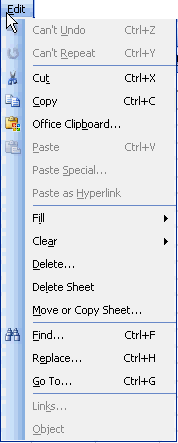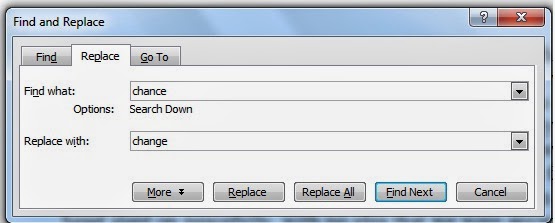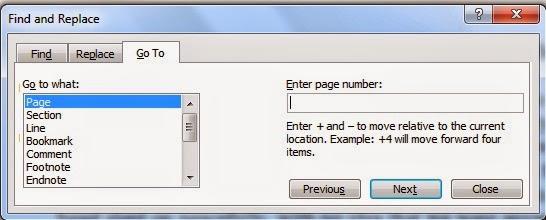
Edit Menu in MS Excel 2003 remains a venerable powerhouse, cherished by many for its simplicity and functionality. Among its arsenal of features, the Edit Menu stands out as a crucial tool for refining and perfecting your data. In this blog post, we’ll delve into the depths of Edit Menu in MS Excel 2003, unraveling its hidden gems and showcasing how mastering its capabilities can significantly enhance your workflow. Whether you’re a seasoned Excel user or just starting your spreadsheet journey, join us on a journey to unlock the full potential of the Edit Menu and take your data manipulation skills to new heights.
Undo (Ctrl+Z):
Cancels the last command run by the Undo option in the Edit Menu in MS Excel 2003. If you type a word and it gets deleted somehow, you can undo it and bring it back.
Table of Contents
Repeat (Ctrl+Y):
Repeats the last command run by this option in the Edit Menu in MS Excel 2003. If you have brought back the deleted word and want it, you can redo it.
Cut (Ctrl+X):
Edit Menu in MS Excel 2003, you can delete the selected object or text from the page through this option. The delete object or text is saved to the clipboard.
Copy (Ctrl+C): Edit Menu in MS Excel 2003
The object or text selected by this option is copied to the clipboard. Instead of typing a word bar, I prefer the copy option.
Office Clipboard:
Edit Menu In MS Excel 2003, we use this option to open the office clipboard pane. In which cut, the copied thing is present? You can bring it whenever you want.
Paste (Ctrl+V):
Through this option, whenever you cut or copy any file text or object. So it is present in the clipboard. The object or text present in the clipboard can be brought into the page.
Paste Special:
Paste special options allow you to paste specific types of information into individual cells. For example, you may want to paste numbers into the first column of a spreadsheet. To do this, select the range you would like to paste (i.e., all rows) and press Ctrl+V. After selecting the destination cell, click inside it and press Enter. Now, you have the option to pick whether you want to put the values into the formula bar, the number pad, or both. Such as RTF, HTML, JPEG, PNG, GIF, etc.
Paste as Hyperlink: Edit Menu in MS Excel 2003
Through this option, two files are linked. To do this, the first file that has to be linked. Please select and copy any character from its text to identify which file’s text it belongs to. After that, the file is to be linked to. Open the file where you want to bring that character.
Put the cursor in that place and click on this option. The copy character will appear at that place. Now whenever you move the cursor on that character, the cursor will change to a hand. Click on this letter will open the linked file.
Note: The file to be linked must be saved. and the file from which the word text is copied. That file must be saved.
Fill:
With the help of this option, we do this to bring the text written in the cell to its right, left, up, down, or in another sheet. Under it are the following options.
- Down: To bring the data written in the top cell to the bottom cell.
- Right: To bring the data written in the left cell to the right cell.
- Up: To bring the data written in the bottom cell to the top cell.
- Left: To bring the data written in the right cell to the left cell.
- Across Worksheet: With the help of this option, you can copy the data from one sheet to another sheet.
- Series: With the help of this option number and date can be brought in a sequence.
- Justify: To put the written text in the lower cell by giving more than one cell.
Clear (Del):
Edit Menu In MS Excel 2003, you can delete the selected object or text through this option. Or you can delete the changes made to it. There are two options under this.
- All: Click on it will delete the selected text as well as the comment. That is, use it to erase all.
- Formats: By this, only the changes made in the text or object can be eliminated.
- Contents: By this only text or object can be erased.
- Comment: By clicking on it, from the selected text, about which you have written a comment. Only that comment will end, not the text.
Delete:
With the help of this option, you can delete the selected cell, column, row, etc.
Benefit: You want the cell to be selected. Instead of this cell, the cell on the right side of the cell on the top side should come. Or like this, the row has been selected. Instead of that row, the row below or the column that has been selected. Instead of that column, the column on the right should come. So to do this, we use the Delete option.
Delete Sheet:
In the Edit Menu in MS Excel 2003, the “Delete Sheet” function within the Edit Menu offers a streamlined way to eliminate unnecessary sheets from your workbook. Simply select the sheet, navigate to the Edit Menu, and choose “Delete Sheet” to declutter your workspace effortlessly. This quick and efficient process ensures a smoother, more organized Excel experience.
Move or Copy Sheet:
With the help of this option, you can prepare a copy of any sheet from the present file book. Similarly, if you want to keep any page from the present file book in another file, then you can keep it.
Find (Ctrl+F):
Edit Menu in MS Excel 2003, you can find any letter or word through this option.
Method: On clicking this option, the dialog box will open, where in the box of Find What, write the letter that you want to find. After that click on Find Next, and that letter will be selected. And if you want more convenience. So click on the More button on the left side of Find Next. In which other options will appear. In them, there is a drop-down box named search on the left side which has three options.
(1) All will find it all over the page. (2) Up will find it from above. (3) It will find it from the bottom.
- Match case: By clicking on this check box, the word you are looking for. Type it into the Find What box as it is on the page. For example, if capital is in later then write in the capital later, and if in small later then write in small later.
- Find the whole word only: By clicking on this check box you can find the only word. Whether it is in the capital later or in a small later.
Use wild card:
Edit Menu in MS Excel 2003 By clicking on this check box, which word or letter is not remembered? Instead, you can use this symbol (*/?) i.e. wildcard. One Question Mark (?) is equal to one letter and one Star (*) is equal to one word.
- Sound like: By selecting this check box you can find words with similar pronunciation. Like- son, sun, there, their etc.
- Find all word forms: This option is used to find all three forms of verbs.
- Format: Through this, changes like paragraph, tab, language, frame, style, highlight, etc. can be done in the changed word.
- Special: It has many features. Like graphics paragraphs letters comments, footnotes, etc. You can find this one by clicking on it.
- No Formatting: By clicking on this tab, you can eliminate the changes made by the Format option.
Note: This button will be activated at the time when by click on the Format button from its left side, you will change it by any of the options present in it.
Replace:
Edit Menu In MS Excel 2003, you can change any searched word through this option.
Method: By clicking on it, a dialog box like Find will open, where only in the box of Replace with, write the word which is to be replaced with the word found. Replace will replace one and replace all, but wherever that word is it will be changed.
Go to: Edit Menu in MS Excel 2003
Through this option, the cursor is used to move to any page, line, paragraph, etc.
Method- By clicking on it, a dialog box named Find Like Go will open. Select any one Page, Section, Line, etc. from the list box of Go to What. After that, in the box of Enter_Number, enter the number where you want to go, after that click on the go-to button. The cursor will reach there.
Link:
This option is used to update the linked object present in the document.
Method: First of all click on the object option in the Insert Menu, and the following dialog box will appear.
In this, by clicking on the tab button of create from a file, select the file that you want to bring through Browse. After this turn on the check box of a link to the file and turn it OK. The link file will appear in your document.
Object: Edit Menu in MS Excel
This option is used to make changes to the object brought from another program.
Method: To run this, click on the object option in the insert menu. A dialog box will open where you select any program in the box of an object type. For example – this program will open as soon as you do Corel Draw then OK. By creating an object here, as soon as you close the program, this object will reach the open file. Now use this object option to make any kind of change in this object. There are two options under this.
- (1) Edit by clicking on this option, you can make changes to the brought object.
- (2) Convert This will only show the name of the Edit Menu in MS Excel 2003 from which the object is fetched.
Conclusion:
In the dynamic landscape of Edit Menu in MS Excel 2003 emerges as an indispensable ally, seamlessly facilitating data manipulation and refining tasks. We’ve explored its array of functions, from the fundamental Cut-Copy-Paste operations to advanced features like Paste Special and linking through Paste as Hyperlink. Mastering these tools empowers both novice and experienced users to elevate their spreadsheet prowess, fostering a more efficient and organized Excel experience.
FAQs:
Q: How can I undo an action in MS Excel 2003?
Utilize the “Undo” function by pressing Ctrl+Z, which cancels the last command, reverting changes made.
Q: What is the significance of Paste Special?
Paste Special allows you to paste specific types of information, such as values, formats, or formulas, offering fine-grained control over data pasting.
Q: How does Paste as Hyperlink work?
This feature links two files by copying a character from one file’s text to identify it. The linked file is then opened by clicking on the linked character.
Q: How can I delete a sheet using the Edit Menu in MS Excel 2003?
To delete a sheet, select it, navigate to the Edit Menu in MS Excel 2003, and choose “Delete Sheet.” This simplifies the process of decluttering your workbook.
Q: How do I use the ‘Go to’ option?
The ‘Go to’ option in the Edit Menu in MS Excel 2003 enables you to navigate the cursor to a specific page, line, or paragraph in your document.



